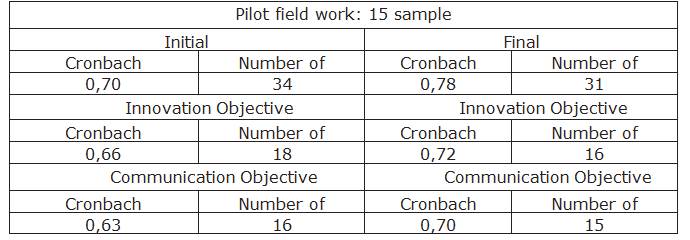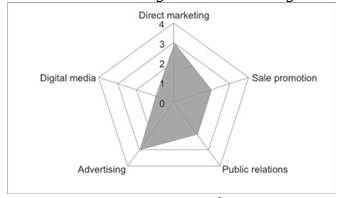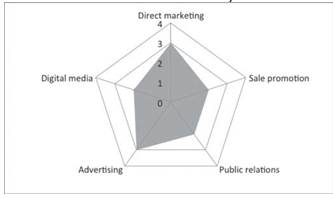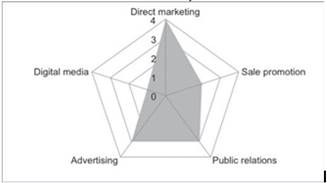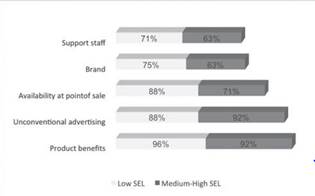1. Introduction
The ranking of any factor will always be an element of evaluative judgement for the organizations. This enables them to prioritize their strategic actions and reduce the margin of error to know where action must be taken, allocating the available resources in an efficient way. This ranking is vital knowledge for decision-making, and as affirmed Valdés (2002, p.1) is the new source of wealth, complementing the classic capital, land and labor.
In the 21st century the complexity around advertising communications has determined with higher priority the value of a congruent message transmission; for example: to let it be known in the terms the person gets it. Integrated Communications Marketing (ICM) considers that consistency as the fundamental way of integration of various tools of communication (Duncan & Moriaty, 1998, p.3). These tools include: direct marketing, sales, public relations, advertising and digital media promotion; the latter is added to the exposed by Wang, Wu, & Yuan, (2009, p.223) and is included for the rapid growth in the adoption of technological advances by people.
The integrated communication of marketing since the early 1990s has become an important point of research and the acceptance of the concept is growing rapidly and although there is no definitive agreement on the concept, the one raised by Seric and Gil is one of the most complete:
Es un proceso táctico y estratégico del negocio, potenciado por los avances en las tecnologías de información y comunicación (TIC) y centrado en el consumidor; que en base a la información sobre los clientes obtenida de las bases de datos, trasmite un mensaje claro y coherente a través de las sinergias de distintas herramientas y canales de comunicación, con el objetivo de crear y mantener el valor de marca y relaciones rentables y duraderas con los clientes y grupos de interés (Seric y Gil, 2012, p. 69).
The above definition recognizes the consumer as the center of integrated communication. It is as well as the relevance of the communication element within a marketing strategy has been exhibited by several authors. Rogers in 995 with his theory of innovation diffusion, proposes five elements so that a business organization grows and reaps its economic benefits. One of them is the channels of communication and by virtue of these, its speed and scope, will allow the company to have five target groups on the market: innovators, early adopters, early majority, late majority and laggards (Rogers, 1995, p. 247).
On the other hand, Tellis in 1992 says that in the current, competitive society, accelerated and information- saturated, strategic marketing has to support four (4) principles: orientation to the consumer, segmentation, differentiation and positioning (Tellis, 1992, p. 21).The author recognizes the origin of business actions in the consumer and not in the market itself. Only when the organization is aligned to know and understand it (i.e. be really oriented to the consumer) can and should it develop the other three principles. The latter was originally laid down by Ries & Trout in 1992, and although its execution requires an article, service, company or person, the concept of positioning is not the product itself but what is done with the mind of probable customers through communication (Ries & Trout, 1992, p.7). Its basic approach is not to create something new and different; but rebind the connections that already exist in the mind.
Latter concepts let us understand communication relevance, which according to Navarro, Piñero & Delgado (2009) should be strategic consistency and to be used in each communication media needed to persuade the target group. Such persuasion is obtained when the consumer is repeatedly exposed to certain information given by the enterprise (Navarro et al. 2009, p. 43). Krugman in 1972 staked a threshold made out of three message expositions, which are the necessary ones to persuade the communication receivers. The first exposition is the interest on every category exposed on the market, getting innovative consumer´s attention proposed by Rogers in 1995. The second calls the interest on the product´s message and calls early adopters and the early majority. The third exposition gives reinforcement on the brand's top of mind and calls the attention of latter majority and laggards consumers. Going in this way from simple exposition (stimuli presentation looking for somebody to perceive it) to repeated exposition (constant stimuli to make brand knowledge and familiarity grow).
Rogers (1995), Tellis (1992) and Krugman (1972) are conceptual frameworks in this article contributing in their respective order: the importance of communication to manage the five consumer groups; the role of the position as a result of persuasion towards the use of the brand; and the threshold of this message repetition as well as potential audiences who will be drawn at every stage of exposure.
Although the theory offered so far shows a synergistic effect on traditional variables in communication (Seung, 2003; Chang and Thorson, 2004; Stammerhohan, Chang and Thorson, 2005), it has not offered empirical evidence corroborating such synergy in the scope of the integration between the various communication tools (Navarro, et al. 2009).
Nor are the effects of the use of these communication tools in the management of 21st century consumers who are increasingly more difficult to surprise and convince to develop markets. This implies a challenge for marketers and so the following guiding questions of the research come to us: What is considered innovative for the younger consumers? Do younger consumers want massive processes and products or do they prefer personalization? What is new in terms of communication tools for young men?
In this article you can see the communication tools ranking and the factors that male consumers resident in Villavicencio expect, young aged between 16 and 18 years and belonging to the low and medium-high Socio Economic Levels (SEL).
Some results allow us to infer that the young have a purchase behavior that can be categorized as members of two major groups proposed by Rogers: early adopters and early majority. Elements such as "fashion" and the "use of products' influence every age group at the time of the purchase, 75% are not willing to wait for the product to be out of fashion to buy it. In medium-high socioeconomic level, 83% of people are not willing to use products out of fashion and in the low socio-economic level for economic reasons it drops to 67%.
There is also a more traditional consumer group for who fashion does not condition them in their actions in the market. 33% are located at the base of the population pyramid and 17% in its middle and upper level.
2. Materials and methods
The results presented, were obtained through the application of the instrument of data collection from young men over 16 and under 18, corresponding to low and medium-high socio economic levels. Sample size was 32 youngsters who gathered characteristics within the general study which took 384 surveys. The selection of informants was performed in a non- probabilistic way at colleges and universities of Villavicencio. The data obtained was processed in SPSS to perform different calculations and uni and bivariate analysis.
In table 1 the changes can be seen both in the initial instrument which had 34 questions in the Likert scale whose alpha of cronbach in the pilot applied to 15 subjects was 0.70. Once set it had 31 questions and an indicator of reliability of 0.78, which places it in the category of acceptable according to Hernandez (1997, p. 378).
The instrument in the field of communication, included questions related to communication tools: direct marketing, promotion, sales, public relations, advertising and digital media.
3. Results
The study was applied to young men who ranged from 16 to 22 years old from different socio-economic strata in the city of Villavicencio. On the one hand, those who live in strata 1 and 2 neighborhoods and form a group of a low Socio Economic Level (SEL). On the other, those who live in strata 3, 4 and 5 neighborhoods and are grouped in the SEL medium-high Level. The total sample will be analyzed first and then there will be the most relevant comparisons by SEL.
One of the first findings was the identification of the direct marketing and mass media as the tools Villavicencio's young men best scored, according to what fig. 1 shows. Sales promotion and public relations are the following two hierarchical tools. Finally and perhaps in a paradoxical way towards modernity and technologically advanced society, live tool digital media was the one which obtained the lowest rate.
Against direct marketing, respondents were in moderate agreement against its importance. The most relevant factor with 94% of acceptance is the direct communication of the benefits of the product.
Advertising is an attractive tool; therefore respondents manifested themselves in moderate agreement with its importance. The study reveals two fundamental ways to establish contact with the consumer and/or possible consumer. The first one is that doing something outside the mainstream television or radio, allows 90% of branding top of mind. The second one reveals that television which reaches 52% of consumption exceeds the 2:1 ratio to the radio as a means by which young men of Villavicencio know what happens with products.
With regard to the importance of sales promotion respondents moderately disagree. It is quite remarkable how 3 out of 4 people surveyed are not willing to wait until the product is out of fashion and find a promotional price to make the purchase.
Public relations reflect a moderate disagreement among the youth in Villavicencio. For 62.5% of them it is more important the product innovation than the philanthropic activities of a brand in a vulnerable community. Thus there is evidence of some level of selfishness in the consumption and the satisfaction they seek with it.
Finally the fifth studied tool was the use of digital media. In this regard, the respondents are in total disagreement and although they are the source of information, for 60% of them (beating TV), only 15% takes into account the presence of the brand in social media as a decisive factor in the purchase. Three out of ten people rely on purchases made over the internet. This form is a way to go with presence on two fronts: the first, education to perform electronic transactions, and the second security in such transactions.
Framing tools and assessed factors in the theory of Rogers (1995), the youth of Villavicencio without interest on the socio-economic level to which they belong, fit target groups of "early adopters" and "early majority". 80% of them want products available at all points of sale and 75% want to make the purchase of their products immediately and they are not willing to wait for the product to be out of fashion to be able to use it or exhaust it, due to the strong influence to exert their peer age in different groups and roles to which every consumer belongs.
Analyzing table 2, it is identified that the brand is the fundamental element for deciding on the purchase of the product by 66.7% of the time. The result of the combination "fashion and brand" can be interpreted as the response of consumers to the persuasion exercise carried out by the companies. In this way the behavior of young man may positively be conditioned by outsiders, being a priority task for companies.
Table 2 Brand as a fundamental attribute in the product election process.
| Qualification | Frequen | Percent | Valid | Accumulated |
| Total | 3 | 8,3 | 8,3 | 8,3 |
| Moderate | 9 | 25,0 | 25,0 | 33,3 |
| Moderate | 17 | 47,2 | 47,2 | 80,6 |
| Total Agree | 7 | 19,4 | 19,4 | 100,0 |
| Total | 36 | 100,0 | 100,0 |
When both studied socio-economic comparative analysis are made, it's shown in figures 2 and 3 that direct marketing is still a very important tool. The assigned qualification on the lowest level belongs to a moderate agree, while in a medium-high level reaches the highest qualification, taken in account as a really relevant matter.
Note also that the public relations tool gets a better rating in the medium-high level than in the lower one, placing its importance in a moderate agreement. Finally, evaluation of digital media only improves at the low level from the total medium-high level.
This comparison shows that direct marketing and advertising are still the two best qualified tools.
Analyzing separately each of the five tools evaluated in each segment with its respective factors, it is evident that their order does not differ, although their rating by SEL does, as expressed in the figure 4, so:
1. Product benefits: is the best rated factor of the direct Marketing tool by all respondents. Its analysis should focus on the need of all consumers in receiving the company products manufacturer, functional information about the benefits they offer. This situation is the one that must create the argumentation of the communication lines, since it is there where the levels of perception are reached and the positioning of the item, service, company or person is formed 96% of the respondents at the low level expect advertising tool factor is linked to the threshold of the expositions. While more attractive is the way to get the message to the target audience, faster is the generated interest in the category and the message. In this way the levels required are reached to convert the category into fashion, with the positioning of the brand.
3. Availability at the sales point: young people want to find the product in the most possible points of sale. This facilitates their acquisition process, since they are groups of consumers who quickly want to be fashionable. Although they are not completely innovative, all young people can be categorized as "early majority consumers". Low socioeconomic levels, with 88% of respondents expect an offer available at many outlets in places near to their place of residence; while the medium- high level reached 71%. In this way, it is evident that mass distribution at retail outlets is a factor of the sales promotion tool, and favors the purchase of products.
4. Brand: This factor is part of the advertising tool and, in a society where offer widely exceeds the demand, products must be seeking promotion in the scale of benefits proposed by Silverstein (2007, p. 18), ceasing to be only functional in order to generate emotional connections with consumers. This change Involves replacing the abstract relationship between consumers and products for the relationship between tastes for branded products that confer a meaning to its different cultural identities (Bourdieu, 1998, p. 99).
In the low socioeconomic level 75% accept brand as a key factor when deciding the purchase of a product. Putting it in another way: 3 out of 4 young people who live in neighborhoods of the city's lower strata, when they make a purchase, they do it looking for the brand. This means that there may be a close relationship between "branded product" and "power" conferred by the brand within their group of influence.
This percentage changes for the medium-high level, where the acceptance of the factor brand as a determinant in the buying process becomes only 66%, entering other additional factors to form part of the decision of this population segment. Thus, in Villavicencio to the segment of young men, the brand of a product occupies the fourth position. It becomes then, a factor to achieve recognition and loyalty in the consumers.
5. Support staff: there is evidence of a gap in the behavior of Villavicencio youngsters against the action of buying. At the point of sales, support staff is a priority for the low level strata, the opposite situation occur in the medium- high level where social media interaction is essential. However, all young people, perhaps by breeding patterns, require approval or validation by someone else. Although the purchase decision is taken, the reinforcement by external agents will always be well received being this fifth factor a fundamental part of direct Marketing or digital media tools depending on the socio-economic level.
In this ranking is not evidenced any relevance by young men, of factors related to the Public Relations tool.
Previous ranking leaves in evidence something since ancient times that had been raised by Aristotle in the century IV BC. (Cited by Metzeltin 2003), when he structured the four different parts of rhetorical speech:
Firstly, Exordium, which seeks to attract the audience. Secondly, exposition, which is the part where the facts underpin demonstration. The third part, Argumentation, exposition of the evidence that confirms the conclusion and the fourth part, Peroration, in this part the public is induced to bend their will for the purposes which are intended to be obtained.
In modern times these same elements together with the findings in this research denote compliance with the acronym communication model A.I.D.A of Attention, Interest, Desire and Action, raised in 1898 by E. Elmo Lewis, spread in 1925 by Strong and cited by García (2011).
In this way, for the young men of Villavicencio the process starts when the manufacturer presents the benefits of the product to call the attention of consumers. The second step is a communication out of the ordinary that sparks interest in the product to communicate and creates empathy with this youth segment. The desire is the third step, and is set at the sales point with a specific brand which has social meaning for this age group and their peers. Finally, the action is reinforced by physical support staff or by digital means for the product purchase.
4. Conclusion
Analyzed young men expect a clear and detailed communication about the benefits that they will get with their purchase from producers of goods and services. That condition can be understood in two ways. The first, concerns to which they are very rational consumers and therefore they seek as much information as they can to allow them to optimize the available monetary resources. The second, they present a marked interest in the purchase of these products and therefore they require information that will help them to decide or to reinforce their choice at the sales point. For future lines of research it will be necessary to study what is the use that young men give to information.
Finally, the results allow establishing that with regard to the transmission of information; young men want this in a different way than the traditional, something that generates higher expectations for them and greater recognition. It is at this point where innovation in communication should focus on conveying the message through non-conventional forms, adjusted to these more digital new consumers, more interactive with the production companies with brands. And although electronic transactions are not the strongest point of this age group, in none of the studied strata, it is clear that two-way communication is what they really expect from the brand.













